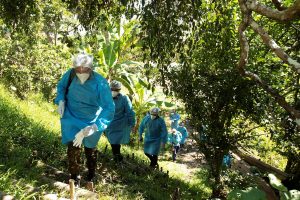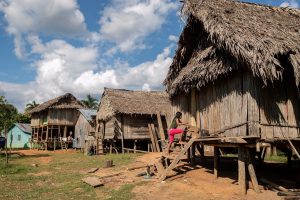
By Joedson Alves
Palmeiras do Javari, Brazil, Jun 21 (EFE).- The indigenous village of Cruzeirinho in the isolated heart of Brazil’s Amazon region has practically been emptied due to fears of contracting the coronavirus among residents, the majority of whom have moved even farther into the jungle seeking a refuge from the pandemic.
Located along the Javari River in the area bordering on Peru, the village is exposed to the daily flow of people who are moving along the Amazon tributary via which the virus has arrived at even the most remote communities.
So, 27 of the Mayuruna tribe’s 32 families living in Cruzeirinho have opted to leave everything behind and voluntarily isolate themselves deep in the jungle to try and escape infection.
“They want to take care of themselves, protect themselves and their children from contracting the coronavirus. It’s a border region and many people pass through here every day, so the people went into the jungle to protect themselves,” Bene Mayuruna, one of the few Indians who decided to remain in the village, told EFE.
The Indians have taken refuge in a region of cropland surrounded by the thick vegetation of the planet’s largest jungle, where they feel “calm.”
“They’re protecting themselves completely isolated in the jungle. They took their children and are remaining there without speaking with anyone,” Mayuruna said.
The decision to take refuge in the jungle was an extreme response to the advance of Covid-19 in the Vale do Javari Indigenous Territory, the region where the largest number of original tribes live unconnected to the rest of the world.
The Vale do Javari, located in the western part of Brazil’s northern state of Amazonas, is the second largest indigenous area in the country and home to thousands of Indians from a number of distinct tribes, 15 of which have never been in contact with the outside world.
This past week, the Brazilian army launched a health mission in the zone, which is some 85,500 square kilometers (32,900 square miles) in size, to contain the spread of the virus among the local communities.
The coronavirus has already infected at least 6,351 Indians and taken the lives of 301, according to figures compiled by Brazil’s Indigenous People Articulation (APIB).

The work of the armed forces is complemented by the different Special Indigenous Health Departments (DSEI) that operate in in the region providing medical attention for the local Indians and, in times of pandemics, also undertaking preventive work to keep the disease out of their communities.
“When the coronavirus erupted, we began to prepare and instruct our technical team that operates in the … Vale do Javari to instruct the indigenous communities on how to prevent the virus from getting into the villages,” Jorge Marubo, the DSEI coordinator in the Vale do Javari area, told EFE.
He said that there is great concern that the coronavirus will spread unchecked among the indigenous population in the region, “one of the (groups) most vulnerable to the dangers of the virus.”
“Here we have Indians who’ve made contact very recently, we have Indians who still live in the traditional way and where not even the common flu is much in evidence,” he said.
However, Marubo added that “Unfortunately, the virus has reached some of the (most vulnerable) villages” in the region, like Sao Luis, located in the heart of the Vale do Javari.
“We’re managing to control the virus,” but “we’ve intensified the work of raising awareness and instructing the Indians so that they remain on alert and don’t allow unknown people into their territories or the exit and re-entry of their own people so that they don’t transmit the virus,” he said.
The DSEI coordinator in Alto Rio do Solimoes, Weydson Gossel Pereira, said that one of the biggest challenges in fighting the virus in the Indian population is the refusal of many local residents to be transported to a hospital.
“Many Indians have refused transfer to a hospital because in the hospital, (if) they die, they’re not buried in the village, with the funeral and burial ceremony (they require). That has prevented them from agreeing to go to hospitals,” Pereira told EFE.
So, the indigenous health care centers have had to “adapt” quickly, although they’re still lacking some essential health supplies and equipment, including respirators and oxygen tanks.
“In particular, we need oxygen support. Before, we only had inhalers, but with Covid-19, with the difficulty … of the cases due to respiratory insufficiency, we decided to adapt,” he said.
He went on to say that, to meet the demand, they acquired 60 oxygen tanks that will be distributed among the 13 health centers in the Vale do Javari area within the coming days.
“Just in our unit we have four cylinders and two special rooms in which to receive patients with respiratory problems, stabilize them and decide if we’ll transfer them to a hospital or not,” Pereira said.
